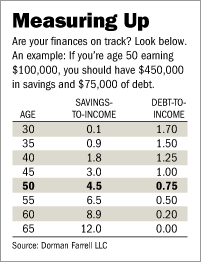kyounge1956
Thinks s/he gets paid by the post
- Joined
- Sep 11, 2008
- Messages
- 2,171
Has anyone else read this? The book provides financial planning formulas into which you can plug your specific information to get the amount you should have accumulated by various certain ages, in order to retire at 65 on 80% of your salary, and the other numbers like savings amounts, debt ratios, etc, that will put you in a position to hit that target.
The first chapter is your capital to income ratio, and the basic assumptions are: 5% withdrawal rate on your savings generates 60% of your final salary, and Social Security provides the other 20%, for a total of 80%. In order for a 5% WR to provide that amount of income, you need to have accumulated 12x your income by age 65. So far, so good.
Where I run into a question is the appendix that tells how to revise the calculation if you have a pension coming. Instead of using your whole salary as a multiplier, the author says to apply the ratio to that portion of your salary that won't be replaced by the pension.
Hasn't the author left out Social Security in making the adjustment? This person has a pension that covers 50%, and (based on the author's assumption) Social Security that covers 20%. Doesn't this mean 70% of his salary will be replaced in retirement, and he only needs to replace the other 30%, making his correct multiplier $18,000), and the required savings amount at age 45 3.7 x $18K=$66,600?
Leaving aside for now the question of whether it's really necessary to have 80% of salary to retire, whether a 5% WR is safe, and how much of the promised Social Security benefits will actually be paid, it still seems to me that one of us—either I or Charles Farrell, J.D., LL.M—is off the mark by a considerable amount.
Which of us is it?
The first chapter is your capital to income ratio, and the basic assumptions are: 5% withdrawal rate on your savings generates 60% of your final salary, and Social Security provides the other 20%, for a total of 80%. In order for a 5% WR to provide that amount of income, you need to have accumulated 12x your income by age 65. So far, so good.
Where I run into a question is the appendix that tells how to revise the calculation if you have a pension coming. Instead of using your whole salary as a multiplier, the author says to apply the ratio to that portion of your salary that won't be replaced by the pension.
"Assume we have a 45-year-old worker who earns $60,000 and will have a pension worth 50% of his pay at retirement. this means the worker needs to figure out how to cover the other $30,000 (50% of his salary) with his own retirement savings. Therefore, the worker should benchmark his Savings Ratio and Capital to Income Ratio using the $30,000 of salary he must cover himself....At age 45, his Capital to income Ratio should be 3.7. The Capital to Income Ratio is applied to the $30,000 of his pay that is not covered by his pension. Thus, at age 45, he should have 3.7 times $30,000 saved, or $110,000."
Hasn't the author left out Social Security in making the adjustment? This person has a pension that covers 50%, and (based on the author's assumption) Social Security that covers 20%. Doesn't this mean 70% of his salary will be replaced in retirement, and he only needs to replace the other 30%, making his correct multiplier $18,000), and the required savings amount at age 45 3.7 x $18K=$66,600?
Leaving aside for now the question of whether it's really necessary to have 80% of salary to retire, whether a 5% WR is safe, and how much of the promised Social Security benefits will actually be paid, it still seems to me that one of us—either I or Charles Farrell, J.D., LL.M—is off the mark by a considerable amount.
Which of us is it?

